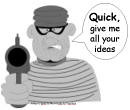 The Thief
The Thief 
Le Voleur is French for the Thief. In 1828, during the birth and rise of the newspaper, Emile de Girardin had a novel idea on how to use the newest writing technology, the printing press. He and a friend decided to start a periodical, but since they lacked capital, the weekly was entitled Le Voleur (The Thief) and it reprinted the best articles that had appeared elsewhere during the week, saving editorial costs. (from ''The History and Power of Writing'')
Tuesday, August 02, 2005
NY Times Op-Ed Contributor: "IT'S summertime, and odds are that at some point during your day you'll reach for a nice cold bottle of water. But before you do, you might want to consider the results of an experiment I conducted with some friends one summer evening last year. On the table were 10 bottles of water, several rows of glasses and some paper for recording our impressions. We were to evaluate samples from each bottle for appearance, odor, flavor, mouth, feel and aftertaste - and our aim was to identify the interloper among the famous names. One of our bottles had been filled from the tap. Would we spot it?
We worked our way through the samples, writing scores for each one. None of us could detect any odor, even when swilling water around in large wine glasses, but other differences between the waters were instantly apparent. Between sips, we cleansed our palates with wine. (It seemed only fair, since water serves the same function at a wine tasting.)
The variation between waters was wide, yet the water from the tap did not stand out: only one of us correctly identified it. This simple experiment seemed to confirm that most people cannot tell the difference between tap water and bottled water. Yet they buy it anyway - and in enormous quantities.
In 2004, Americans, on average, drank 24 gallons of bottled water, making it second only to carbonated soft drinks in popularity. Furthermore, consumption of bottled water is growing more quickly than that of soft drinks and has more than doubled in the past decade. This year, Americans will spend around $9.8 billion on bottled water, according to the Beverage Marketing Corporation.
Ounce for ounce, it costs more than gasoline, even at today's high gasoline prices; depending on the brand, it costs 250 to 10,000 times more than tap water. Globally, bottled water is now a $46 billion industry. Why has it become so popular?"
We worked our way through the samples, writing scores for each one. None of us could detect any odor, even when swilling water around in large wine glasses, but other differences between the waters were instantly apparent. Between sips, we cleansed our palates with wine. (It seemed only fair, since water serves the same function at a wine tasting.)
The variation between waters was wide, yet the water from the tap did not stand out: only one of us correctly identified it. This simple experiment seemed to confirm that most people cannot tell the difference between tap water and bottled water. Yet they buy it anyway - and in enormous quantities.
In 2004, Americans, on average, drank 24 gallons of bottled water, making it second only to carbonated soft drinks in popularity. Furthermore, consumption of bottled water is growing more quickly than that of soft drinks and has more than doubled in the past decade. This year, Americans will spend around $9.8 billion on bottled water, according to the Beverage Marketing Corporation.
Ounce for ounce, it costs more than gasoline, even at today's high gasoline prices; depending on the brand, it costs 250 to 10,000 times more than tap water. Globally, bottled water is now a $46 billion industry. Why has it become so popular?"
0 Comments:
GoogleNews Map
NY Times
Cost of the War in Iraq
(JavaScript Error)

| CURRENT MOON lunar phases |
Play Chess
RSS
Fighting the Good Fight
- Democracy Now!
- Crooks and Liars
- Common Dreams
- Money in Politics
- The Drudge Report
- Corporation Watch
- Noam Chomsky
- Info Wars
- Free Press
- Bill of Rights
- US Constitution
- Z Magazine
- Save the Internet
- Military Industrial Complex
- Stop Illegal Spying









2005-02-13
2005-02-20
2005-02-27
2005-03-06
2005-03-13
2005-03-20
2005-03-27
2005-04-03
2005-04-10
2005-04-17
2005-04-24
2005-05-01
2005-05-15
2005-05-29
2005-06-05
2005-06-19
2005-06-26
2005-07-03
2005-07-10
2005-07-17
2005-07-24
2005-07-31
2005-08-07
2005-08-14
2005-08-21
2005-08-28
2005-09-04
2005-09-11
2005-09-18
2005-09-25
2005-10-02
2005-10-09
2005-10-16
2005-10-23
2005-10-30
2005-11-06
2005-11-13
2005-11-20
2005-11-27
2005-12-04
2005-12-11
2005-12-18
2006-01-01
2006-01-22
2006-02-05
2006-02-19
2006-02-26
2006-03-05
2006-03-12
2006-03-19
2006-03-26
2006-04-09
2006-04-30
2006-05-14
2006-05-21
2006-06-18
2006-06-25
2006-07-02
2006-07-09
2006-07-23
2006-08-06
2006-12-17